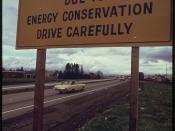Mitigation Strategies � PAGE \* MERGEFORMAT �8�
Mitigation Strategies and Solutions
Jeff Weigel
Axia College of University of Phoenix
March 3, 2008
Energy conservation is the only way to reduce the risk of running out of energy in the future. Continuing to use energy at the rate we are now, will definitely deplete the energy supply. The U.S. Energy Information Administration (EIA) indicates that U.S. energy consumption is about 100 quadrillion Btu/year (105.5 quadrillion kJ/year) (where one quadrillion is 10 to the power 15) and is projected to rise by 37% over the next 20 years. In contrast, the world's energy consumption is around 400 quadrillion Btu/year (422 quadrillion kJ/year) with a projected increase of 53% over the next 20 years and 70% between 2003 and 2030 per the EIA (www.eia.doe.gov/emeu/consumption/index.html). This is important, not only due to finite world energy resources, but also due to escalating CO2 and greenhouse gas emissions.
The U.S. is building 151 coal-fired electrical generating plants to meet present demands, and that number is expected to rise. Coal-fired plants constitute almost 50% of base-load electrical generation in the U.S., per Figure 1. Despite our present efforts, the current trend in U.S. annual CO2 and greenhouse gas emissions inevitably will increase significantly over the next 20 years, unless we take radical action now (Holness, 2008).
Some of the living factors that contribute to the problem that warrants energy conservation is the misuse of energy. People leave the lights or television on when they are not in the room; if they are only leaving for a minute it would not make sense to turn them off. If one is leaving the room to watch television or do another activity than the light should be shut off.
Some humans have a positive impact on energy conservation and...


